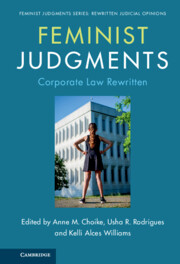Book contents
- Feminist Judgments: Corporate Law Rewritten
- Feminist Judgments Series Editors
- Advisory Panel for Feminist Judgments Series
- Feminist Judgments: Corporate Law Rewritten
- Copyright page
- Dedication
- Contents
- Advisory Panel for Feminist Judgments: Corporate Law Rewritten
- Notes on Contributors
- Acknowledgments
- About the Cover Art
- Table of Cases
- Part I Introduction and Overview
- Part II Legal Personality, Identity, and Limited Liability of Corporate Entities
- Part III Role and Purpose of the Corporation and Corporate Combinations in Society
- Part IV Fiduciary Duties in Corporate Governance
- Part V Closely Held Businesses and Other Considerations Regarding the Composition of Boards, Management, and Owners
- Part VI Protecting Investors and Potential Investors in Corporations
- 15 Commentary on SEC v. W. J. Howey Co. et al.
- 16 Commentary on U.S. v. Chestman
- Part VII From Foundations to Future Directions
- Index
16 - Commentary on U.S. v. Chestman
from Part VI - Protecting Investors and Potential Investors in Corporations
Published online by Cambridge University Press: 15 January 2023
- Feminist Judgments: Corporate Law Rewritten
- Feminist Judgments Series Editors
- Advisory Panel for Feminist Judgments Series
- Feminist Judgments: Corporate Law Rewritten
- Copyright page
- Dedication
- Contents
- Advisory Panel for Feminist Judgments: Corporate Law Rewritten
- Notes on Contributors
- Acknowledgments
- About the Cover Art
- Table of Cases
- Part I Introduction and Overview
- Part II Legal Personality, Identity, and Limited Liability of Corporate Entities
- Part III Role and Purpose of the Corporation and Corporate Combinations in Society
- Part IV Fiduciary Duties in Corporate Governance
- Part V Closely Held Businesses and Other Considerations Regarding the Composition of Boards, Management, and Owners
- Part VI Protecting Investors and Potential Investors in Corporations
- 15 Commentary on SEC v. W. J. Howey Co. et al.
- 16 Commentary on U.S. v. Chestman
- Part VII From Foundations to Future Directions
- Index
Summary
In U.S. v. Chestman, the Second Circuit applied the misappropriation theory to insider trading. Robert Chestman, a stockbroker, received a tip from his client Keith Loeb, who was informed of material nonpublic information by his wife Susan. The misappropriation theory finds liability when a party fails to disclose the use of confidential information for trading and tipping to the party to whom a duty of confidence and trust is owed. The Chestman court used the theory but decided that Susan gave the information “gratuitously” to Keith without expectation of confidence; therefore, Chestman’s conviction could not be sustained under the misappropriation theory. Unlike this restrictive definition of fiduciary relationships, Professor Karen Woody, writing as Judge Woody in her rewritten opinion, instead finds that Keith breached a duty of confidence to Susan. As highlighted by Professor Donna Nagy in her commentary on Woody’s opinion, Susan’s choice to trust her husband was not – and should not be – an individual choice or a rebuttable presumption, but rather a fundamental feature of marriage as “definitionally a relationship of trust and confidence.” Nagy’s commentary explains the courage of augmenting spousal duties of trust and confidence, despite declining marriage rates amidst the emergence of the third wave of feminism.
Keywords
- Type
- Chapter
- Information
- Feminist Judgments: Corporate Law Rewritten , pp. 396 - 416Publisher: Cambridge University PressPrint publication year: 2023

